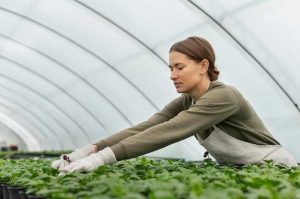

As the world around us continues to evolve, so too must our approach to agriculture. The intricate dance between nature and farming practices has always been a delicate one, with each influencing the other in a perpetual cycle. However, in recent years, the impact of climate change has become increasingly apparent, presenting new challenges and opportunities for those involved in the agricultural sector.
Embracing the Dynamic Nature of Our Surroundings
Our environment is a complex tapestry of interconnected systems, each playing a vital role in the overall balance of our planet. From the gentle sway of the wind to the rhythmic ebb and flow of water, these natural forces shape the very foundation of agriculture. Yet, as the climate continues to shift, so too do these forces, demanding that we adapt our practices to ensure the continued success and sustainability of our agricultural endeavors.
Recognizing the Resilience of Farmers
Throughout history, farmers have demonstrated an incredible ability to adapt to changing circumstances. They have weathered storms, both literal and metaphorical, and have found innovative solutions to overcome the challenges presented by an ever-changing environment. It is this resilience that will once again be called upon as we face the impacts of climate change on our agricultural systems.
Forging a Path Forward
While the effects of climate change on agriculture may seem daunting, they also present an opportunity for growth and innovation. By embracing new technologies, implementing sustainable practices, and fostering collaboration between farmers, scientists, and policymakers, we can forge a path forward that ensures the resilience and adaptability of our agricultural systems.
Ultimately, the future of agriculture lies in our ability to recognize and respond to the changing environmental conditions that surround us. By harnessing the power of nature and embracing the ingenuity of those who work the land, we can create a sustainable and thriving agricultural sector that not only withstands the challenges of climate change but also thrives in the face of adversity.
Understanding the Impact of Climate Change on Agriculture
Exploring the consequences of climate change on the agricultural sector is crucial in order to comprehend the effects of this global phenomenon on food production and security. By analyzing the intricate relationship between climate patterns and agricultural practices, we can gain valuable insights into the challenges and opportunities that lie ahead.
1. Climate Variability and Crop Yield
One of the key aspects to consider when examining the impact of climate change on agriculture is the variability in weather patterns. Fluctuations in temperature, precipitation, and extreme weather events can significantly affect crop yield and quality. Understanding the specific ways in which different crops respond to these changes is essential for developing strategies to mitigate potential losses and optimize agricultural productivity.
2. Shifts in Growing Seasons and Geographic Distribution
Climate change can also lead to shifts in growing seasons and the geographic distribution of crops. As temperatures rise and rainfall patterns change, certain regions may become less suitable for traditional agricultural practices, while others may experience increased suitability. This necessitates a thorough examination of the potential impacts on crop suitability and the need for adaptive measures such as crop diversification and the development of new farming techniques.
- Exploring the relationship between climate change and pest/disease outbreaks
- Assessing the impact of changing water availability on irrigation practices
- Examining the role of climate change in altering soil fertility and nutrient availability
- Understanding the implications of climate change on livestock production and animal husbandry
By delving into these various aspects, we can gain a comprehensive understanding of how climate change affects agriculture and develop effective strategies to ensure food security and sustainability in the face of changing environmental conditions.
Strategies for Adapting Agriculture to Evolving Ecological Circumstances
In order to ensure the sustainability and productivity of agricultural systems amidst changing ecological dynamics, it is imperative to implement strategic measures that effectively address the challenges posed by evolving environmental conditions. This section explores a range of strategies that can be employed to adapt agricultural practices and mitigate the potential impacts of these changes.
Enhancing Resilience through Diversification
One key approach to adapting agriculture to shifting environmental conditions is through the promotion of diversification. By cultivating a variety of crops and livestock breeds that are resilient to different ecological stressors, farmers can reduce their vulnerability to climate fluctuations and other environmental challenges. Diversification not only helps to safeguard against potential losses but also enhances ecosystem stability and promotes sustainable agricultural practices.
Implementing Precision Farming Techniques
Precision farming techniques offer significant potential in adapting agriculture to changing environmental conditions. By utilizing advanced technologies such as remote sensing, geographic information systems (GIS), and global positioning systems (GPS), farmers can gather precise data on soil conditions, weather patterns, and crop health. This information enables them to optimize resource allocation, tailor irrigation and fertilization practices, and make informed decisions to maximize productivity while minimizing environmental impacts.
Furthermore, precision farming techniques facilitate the adoption of site-specific management strategies, allowing farmers to respond effectively to localized variations in environmental conditions. By tailoring agricultural practices to specific microclimates and soil characteristics, farmers can optimize yields, reduce resource wastage, and enhance overall sustainability.
Overall, the implementation of diversification and precision farming techniques represents just a few of the many strategies available for adapting agriculture to evolving ecological circumstances. By embracing these approaches and exploring innovative solutions, farmers can navigate the challenges posed by changing environmental conditions and ensure the long-term viability of agricultural systems.
Enhancing Resilience in Agricultural Systems
In the face of evolving environmental dynamics, it is crucial to bolster the capacity of agricultural systems to withstand and recover from various challenges. This section explores strategies aimed at strengthening the resilience of farming practices and techniques, enabling them to adapt and thrive in the face of changing conditions.
Building robustness
One key aspect of enhancing resilience in agricultural systems involves building robustness. This entails developing farming methods that are flexible and adaptable, capable of withstanding fluctuations in temperature, precipitation, and other environmental factors. By implementing diverse and dynamic approaches, farmers can mitigate the risks associated with climate variability and ensure the long-term sustainability of their operations.
Fostering biodiversity
Another crucial element in enhancing resilience is fostering biodiversity within agricultural systems. By promoting a wide range of plant and animal species, farmers can create more resilient ecosystems that are better equipped to withstand disturbances. Biodiversity not only enhances the stability of agricultural systems but also provides natural pest control, nutrient cycling, and other ecosystem services that contribute to overall productivity.
Investing in research and innovation
To enhance resilience, it is essential to invest in research and innovation. By continuously exploring new technologies, practices, and approaches, farmers can stay ahead of emerging challenges and adapt their methods accordingly. This includes developing climate-smart agricultural techniques, utilizing precision farming technologies, and harnessing the power of data-driven decision-making to optimize resource allocation and minimize environmental impacts.
Empowering farmers
Lastly, enhancing resilience in agricultural systems requires empowering farmers with knowledge, resources, and support. Providing access to information, training programs, and financial incentives can enable farmers to make informed decisions and implement sustainable practices. Additionally, fostering collaboration and knowledge-sharing among farmers, researchers, and policymakers can facilitate the exchange of best practices and innovative solutions, further strengthening the resilience of agricultural systems.
By embracing these strategies and approaches, agricultural systems can enhance their resilience, ensuring the continued production of food, fiber, and other essential resources in the face of changing environmental conditions.
Implementing Sustainable Farming Practices
Incorporating eco-friendly techniques and methods into agricultural practices is crucial for ensuring the long-term viability and resilience of farming systems. By embracing sustainable farming practices, farmers can mitigate the negative impacts of changing environmental conditions and contribute to the preservation of natural resources.
One key aspect of implementing sustainable farming practices is the adoption of organic farming methods. Organic farming relies on natural processes and avoids the use of synthetic chemicals, such as pesticides and fertilizers. Instead, it emphasizes the use of organic inputs, crop rotation, and biological pest control to maintain soil fertility and minimize environmental pollution.
Another important practice is the implementation of precision agriculture techniques. Precision agriculture utilizes advanced technologies, such as GPS and remote sensing, to optimize the use of resources, such as water, fertilizers, and pesticides. By precisely targeting inputs based on the specific needs of each crop or field, farmers can reduce waste and minimize the environmental impact of their operations.
Furthermore, diversifying crop rotations and implementing agroforestry systems can enhance the sustainability of farming practices. Crop rotation involves alternating the cultivation of different crops in a specific sequence, which helps break pest and disease cycles, improve soil health, and reduce the reliance on chemical inputs. Agroforestry, on the other hand, integrates trees and shrubs with crops or livestock, providing multiple benefits such as improved soil fertility, enhanced biodiversity, and climate change mitigation.
Additionally, water management plays a crucial role in sustainable farming practices. Implementing efficient irrigation systems, such as drip irrigation or precision sprinklers, can minimize water wastage and optimize water use. Moreover, the adoption of water-saving techniques, such as rainwater harvesting and conservation tillage, can help farmers cope with water scarcity and reduce the pressure on freshwater resources.
Lastly, promoting sustainable livestock management practices is essential for achieving sustainable agriculture. This includes ensuring proper animal welfare, reducing the use of antibiotics and hormones, and implementing rotational grazing systems. By adopting these practices, farmers can minimize the environmental impact of livestock production and contribute to the overall sustainability of the agricultural sector.
- Embrace organic farming methods
- Implement precision agriculture techniques
- Diversify crop rotations and adopt agroforestry systems
- Manage water resources efficiently
- Promote sustainable livestock management practices
By implementing these sustainable farming practices, farmers can not only adapt to changing environmental conditions but also contribute to the conservation of natural resources, reduce greenhouse gas emissions, and ensure the long-term viability of agriculture for future generations.
Harnessing Technology for Climate-Smart Agriculture
In this section, we explore the potential of utilizing advanced technological solutions to enhance the resilience and sustainability of agricultural practices in the face of changing environmental circumstances. By leveraging cutting-edge innovations, farmers can optimize their operations, mitigate the impacts of climate change, and ensure the long-term viability of their agricultural systems.
One key aspect of harnessing technology for climate-smart agriculture is the adoption of precision farming techniques. Through the use of remote sensing technologies, such as drones and satellite imagery, farmers can gather accurate and real-time data on various environmental parameters, including temperature, moisture levels, and soil fertility. This data can then be analyzed and used to make informed decisions regarding irrigation, fertilization, and pest control, leading to more efficient resource utilization and reduced environmental impact.
Another promising area of technology integration in agriculture is the development of smart farming systems. These systems utilize Internet of Things (IoT) devices and sensors to monitor and control various aspects of agricultural operations. For example, smart irrigation systems can automatically adjust water usage based on real-time weather conditions, ensuring optimal irrigation while minimizing water waste. Similarly, smart pest management systems can detect and respond to pest infestations in a timely manner, reducing the need for chemical pesticides and promoting ecological balance.
Furthermore, the application of data analytics and machine learning algorithms can greatly enhance the predictive capabilities of agricultural systems. By analyzing historical climate data, crop performance, and other relevant factors, these technologies can generate accurate forecasts and models to guide decision-making. This enables farmers to anticipate and adapt to changing environmental conditions, optimize crop selection and planting schedules, and minimize yield losses due to climate-related factors.
Lastly, the integration of renewable energy sources into agricultural operations can contribute to both climate change mitigation and adaptation. Solar panels and wind turbines can provide clean and sustainable energy for powering farm machinery, irrigation systems, and other agricultural processes. By reducing reliance on fossil fuels, farmers can reduce greenhouse gas emissions and contribute to a more sustainable and resilient agricultural sector.
| Benefits of Harnessing Technology for Climate-Smart Agriculture |
|---|
| Improved resource efficiency |
| Enhanced crop productivity and quality |
| Reduced environmental impact |
| Increased resilience to climate change |
| Promotion of sustainable agricultural practices |
Collaborative Efforts for Climate Change Adaptation in Agricultural Practices
In order to address the challenges posed by the changing climatic conditions on agricultural productivity, collaborative efforts are crucial. By fostering partnerships and cooperation among various stakeholders, we can develop effective strategies and solutions to adapt agricultural practices to the impacts of climate change.
Working together, researchers, farmers, policymakers, and industry experts can share knowledge, expertise, and resources to identify innovative approaches for climate change adaptation in agriculture. By pooling our collective wisdom, we can develop resilient farming systems that are better equipped to withstand the challenges of a changing climate.
Collaboration also enables the exchange of best practices and lessons learned from different regions and countries. By learning from successful adaptation initiatives, we can avoid reinventing the wheel and instead build upon existing knowledge and experiences. This can lead to more efficient and effective adaptation strategies, tailored to the specific needs and conditions of different agricultural landscapes.
Furthermore, collaborative efforts can help mobilize financial resources and support for climate change adaptation in agriculture. By joining forces, stakeholders can advocate for increased funding and investment in research, technology development, and capacity building. This can ensure that farmers have access to the necessary tools, information, and training to implement climate-smart practices and technologies.
Ultimately, collaborative efforts for climate change adaptation in agriculture are essential for building a sustainable and resilient food system. By working together, we can develop and implement strategies that not only mitigate the negative impacts of climate change but also enhance the adaptive capacity of agricultural systems. Through collaboration, we can create a future where agriculture thrives in the face of changing environmental conditions.





